 |
Underside of a piece of clay tobacco pipe,
found at Horns Stairs, with some very
delicate leaf decoration where the bowl begins,
and the characters A and O either side of the heel |
I checked the
PLA tide tables went for a walk around the perimeter of Rotherhithe on Thursday (yesterday) to see where the steps that lead down to the foreshore are located, and what the differences are between the accessible foreshore areas. It was another lovely day and a very enjoyable walk, looking down at the water's edge as well as at the buildings opposite.
There are a number of staircases still functioning that lead from the Thames Path down to the water, once the watermen's stairs which were used by "watermen" who operated small passenger boats and accessed them via the staircases between the built up waterfront buildings, and had their own association, the
Company of Watermen and Lightermen. There used to be 13 staircases in Rotherhithe. The general public could also access the river by public rights of way, which enabled them to access the river from Rotherhithe Street to pick up passenger boats. The best known of these, due to the preservation of its sign, is the one that runs down the eastern side of the Mayflower public house (whilst the Church Stairs ran down the western side of the same pub).
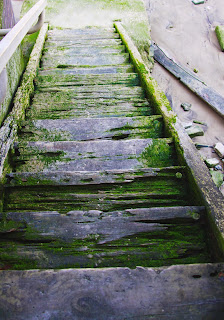 |
| Horns Stairs |
Following on from my previous health-and-safety type comments about the foreshore itself, the stairs do require a bit of a warning too. At this time of the year the weed visible in the photo to the left is dry by low tide, but during the winter these weeds are incredibly slippery and with or without weeds, the lowest steps require caution just because of the residual mud. Most of the staircases have handrails but the general rule is that it's important not be gung-ho about either the stairs or the foreshore itself.
Starting downriver (at the eastern extent of Rotherhithe), the first is the set of stairs by South Dock, which were named the
Dog and Duck Stairs after a nearby pub that was destroyed during WWII. The stairs lead to the section immediately beneath the Thames Clipper pier, and it is a very small area of foreshore, which I have never seen connect to other areas of the foreshore and is always penned in by water. I didn't go down, although it is accessible through a gate that isn't locked, but it looks worth a visit.
The next set of stairs are the
Acorn Stairs immediately upriver from the Surrey Docks Farm, where the Lottery project has been working (and will be continuing to work in September). These stairs were also named after a pub that no longer stands due to war damage. I've already talked about the foreshore
on a recent previous post, so I won't repeat myself here. I took the stairs back up to the Thames Path to walk to the next set of steps, but if you are prepared to brave the mud in front of the Nelson dry-dock (wellies essential, because it is very sludgy and has a lot of suction), you can walk around the dock entrance to the Horns stairs at the Hilton Hotel. Nelson Dock is built at a point in the Thames called Cuckold's Point, marking the point at which Limehouse Reach becomes Lower Pool.
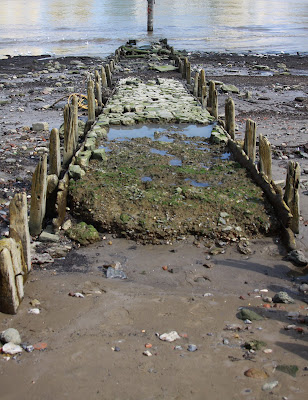 |
| Former jetty at Horns Stairs |
The stairs beyond Nelson Dock and the Hilton Hotel are at the point where you can rejoin the Thames Path at Canada Wharf after being forced to circle the Hilton along Rotherhithe Street, going up the steps. They are called the
Horns Stairs. Again, they were named after a nearby pub, the Horns Tavern, which closed in 1896. The stairs are wooden (shown at the top of this post) and although they seem fairly structurally sound, are a bit unnerving due to all the gaps. At the bottom there is an area more like a beach than the shifting carpet of bricks and stones in
front of the Surrey Docks Farm. Most of it is a beach-like surface with debris strewn along it, although there's an area where roughly shaped cream-coloured blocks are gathered, which may be the surviving remains of a local structure. With your back to the water, there are great views up to Columbia Wharf, the original 19th Century building that has been incorporated into the Hilton, and which has some very distinctive decorative brickwork. It is also an opportunity to walk up and get a good view of the blocking caisson of one of the Nelson Dock's remaining dry docks, which now preserves Thomas Bilbe's patented slip. When I first moved here the dry dock housed a small sailing ship called the
Dame de Serk, which had been converted into a rather good restaurant, but the slip is now ship-free.
Today there were lots of seagulls, adults and juveniles, at the water's edge picking out something that was obviously providing them with some sort of food. Although there are relatively few objects to be found on the beach, the dispersed nature of the debris means that it is easy to pick out individual items, and I picked up a nice piece of clay pipe - nothing very special but with a delicate piece of decoration on the tiny piece of the bowl that remained.
There is, however, a very interesting set of structural features immediately at the bottom of the stairs (see photo above). These mark the jetty and pier that once reached out over the mud for the ferry service to Limehouse Hole. Former ferry piers and jetties are usually good places to search for objects at low tide, but the tides don't seem to favour collection of objects at this particular point.
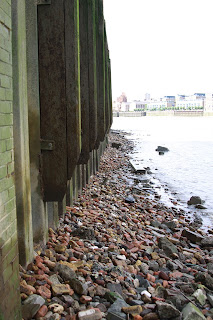 |
Narrow section of foreshore at
Pageants Stairs |
The next set of stairs, still walking upriver towards Tower Bridge, are the
Pageant Stairs, just beyond the obelisk at Pageant Crescent. The reason for the name of the stairs is unknown, because there doesn't seem to have been a pub of that name in the vicinity. The stairs are steep and lead down to a very narrow section of foreshore, which is liberally littered with stones and bricks, which seem to form quite a dense layer. This is the part of the river where I really wouldn't recommend trying to get around the corner on the foreshore itself, because as you look upriver to the left it is very narrow even at low tide (see photo left). But if you like picking out small objects, there was a lot here in amongst the fragmentary rubble. The photograph at the end of the post, of the top of a ceramic vessel, with the original cork still in position, was taken here. I nearly got very wet feet here when Thames Clipper shot past and created a set of waves that travelled quite a long way up the very short sloping beach. The barquetine mentioned in the previous post drifted past on her way to Tower Bridge as I stood here, and it was lovely to stand right at the river's edge and watch her go past.
 Globe Stairs
Globe Stairs are located just downriver of Globe Wharf. You need to pass through a small gate to access them, but this is not locked. The material here is much more fragmentary, reduced to a dark grey gravel over the decades. There were very few surviving objects and the small number that I found were of the more robust variety, and were very water worn. It is just as well that it isn't a promising area for small finds discoveries because it felt more than a little intrusive to be walking around in such proximity to Globe Wharf, because it
has been converted into apartments. I could
hear knives and forks on plates on a balcony above me, and there was a lovely aroma of garlic. I was a lot happier wandering
around where I didn't feel that I was disturbing someone's lunch by
fossicking around at the water's edge outside their home. On the other hand, if you like the 19th Century conversions along the riverfront, this is by far the best way to see the riverside frontage of Globe Wharf itself. The 1914 Ordnance Survey map shows a jetty leading down to "Globe Stairs Pier," but there were no signs of the remains of this at the time I was there.
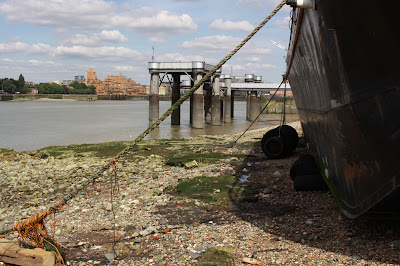 |
| Under the bow of the houseboat at Hanover Stairs |
Just beyond the 1882 gasworks pier, now known as Clarence Pier, and precisely where the ubiquitous houseboat is moored, is another staircase, the
Hanover Stairs. Again, you need to pass through an unlocked gate. At the bottom of the stairs you have to duck under a mooring chain to walk down onto the the foreshore, and you need to skirt the boat as it rests on the ground to walk back to the east, but it's not an obstruction. From here it is
an easy walk along the foreshore to the next set of stairs at the Angel
public house (the modern replacement for
Kings Stairs), with views up to Tower Bridge. The site either side of the stairs was occupied by Talbot and Brothers, who built wooden and iron hulled barges. There are a lot of worked wood planks scattered around here, very large pieces that certainly come from old boats. The Thames Discovery Programme has done survey work here in the past, and
one of their short reports, with a table of their main findings, is currently available on Scribd. Curved, carefully shaped and marked by holes where ship nails would have fitted, these timbers are a nice survival of the area's boat-building past.
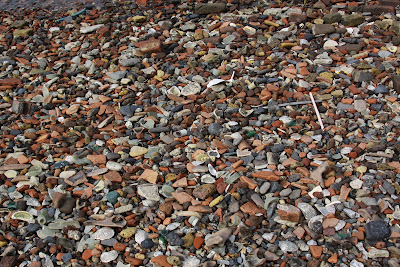 |
| The foreshore at the Surrey Dock Stairs |
This stretch of the river was much more like the Surrey Docks Farm stretch, with a lot of brickwork and stones extending over a very wide stretch of the foreshore. It shelves quite steeply down to the river. There were more pieces of clay pipe than I could actually get my head around, and a lot of very large and sharp pieces of glass. A lot of china and coarse ceramics had washed up, and it was a kaleidoscope of colour and shapes. I was by no means the only person pottering around in the stones and mud, and I suspect that this is a favourite place for people looking for goodies at the water's edge. It is also possible to walk for a long way, there are some very attractive buildings above (which, if you want to get a good look at building frontages, are much best seen from the foreshore than the Thames Clipper, which moves so quickly along this stretch) and there are some great views of well known London sights, so it's a really nice place to go for a wander.
Another set of stairs, Church Stairs, run down the side of the Mayflower public house but are inaccessible today thanks to a large locked gate. Horseferry Stairs used to be located midway down Sovereign Crescent but
it, and the dry dock marked on the 1914 map of the area, have also vanished. It's the same story for King and Queen Stairs, which were downriver from the modern Old Salt Quay public house.
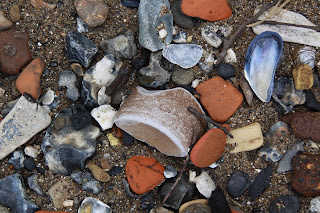 |
A colourful mix of oyster and mussel shells,
broken brick and Victorian ceramics. |
At a very low tide, bearing in mind the very narrow stretch at Pageant's Stairs where you might have to paddle, you could probably walk from South Dock to the Angel public house along the foreshore. You can find this information from the
Port of London Authority website, using North Woolwich as a guide, which not only gives you high and low tides but shows the heights estimated at those times. Yesterday, for example, the low tides were at 0008 (1.39m) and 1227 (1.53m) and high tides were at 0639 (5.97m) and 1904 (5.88m). With 4 metres between high tide and low tide, it is important to get this right :-). On Saturday 21st at 0855 the tide is particularly low, at 0.57m, nearly a metre lower than Thursday's jaunt.
I walked back up to the red bascule bridge, crossed the road to Surrey Water, where a nice selection of water birds were enjoying the sunshine, and cut back to Greenland Dock via the Albion Channel, where there the water lilies are just coming into flower. I then crossed one of the bridges and went into the Russia Dock woodland. It has been good, over the last few days, to see Russia Dock Woodland looking so neat and tidy, and so well used.
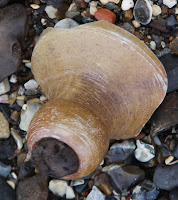
After four days in Paris and two obsessive days wandering around Rotherhithe, my feet were feeling the activity, but my ankles hurt even more, because even though I have been nagging on about appropriate footwear, the weather has been so gorgeous that wellies, hiking boots or anything else that gets in the way of nicely aerated toes seemed so tedious. All well and good on the area under the Hilton where it is just like a beach, but very tough on the ankles where the bricks and stones shift endlessly under foot. Appropriate footwear is seriously recommended; neon pink fashion trainers with no ankle support are not. I was also wearing shorts, which are great on a sunny day, but the sheer amount of fresh glass under foot is astounding and slipping and falling could have been very messy. I do recommend being careful about walking on the loose stone and brick, and taking measures against the sharp things that lurk under and in the mud.
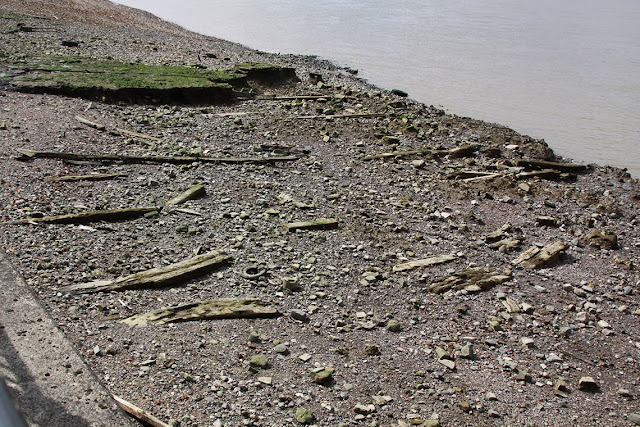 |
Timbers near Clarence Pier at the foot of Hanover Stairs,
surveyed some years ago by the Thames Discovery Programme |











